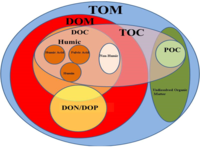
Photo from wikipedia
The aptness of the ∑SEM/AVS (Simultaneously Extracted Metals/Acid Volatile Sulfides) index to ascertain environmental risk from potentially toxic elements in calcareous saltmarsh soils was tested using Structural Equation Modelling. This… Click to show full abstract
The aptness of the ∑SEM/AVS (Simultaneously Extracted Metals/Acid Volatile Sulfides) index to ascertain environmental risk from potentially toxic elements in calcareous saltmarsh soils was tested using Structural Equation Modelling. This technique allows to detect both direct and indirect relationships among AVS, SEM and other soil variables, representing results in a graphical view. The dataset included 90 soil samples from 21 different sites belonging to six different saltmarshes and featured a wide range of soil chemico-physical properties. Variables included in the a priori model were hydroperiod, pH, soil redox potential, labile organic carbon, carbonates, total Fe and total amount of potentially toxic elements (PTE). The best optimised model pointed out the main soil properties which affect AVS accumulation and SEM speciation in these soils. Effect plots of AVS and SEM calculated with the partial linear mixed-effects models included in the piecewise Structural Equation Modelling showed a significant and positive influence of pH and of carbonates on AVS and a highly significant effect of carbonates and labile organic carbon on SEM. Single SEM components were also considered separately in order to define potential contributions of labile organic carbon or carbonates as alternative binding phases. Simultaneously extracted Cu, Ni and Zn resulted preferentially bound to carbonates followed by labile organic carbon, whereas Pb and Cd were easily bound to labile organic carbon. This article is protected by copyright. All rights reserved.
Journal Title: Environmental toxicology and chemistry
Year Published: 2019
Link to full text (if available)
Share on Social Media: Sign Up to like & get
recommendations!